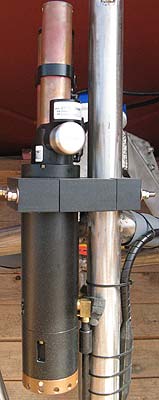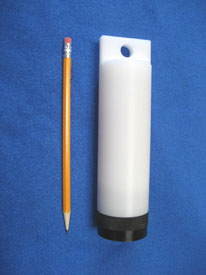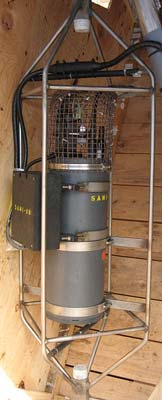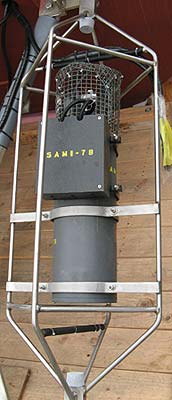Seawater Temperature, Conductivity & Salinity
Instrument Type: Wetlabs Water Quality Monitor (WQM), with Seabird Conductivity cell and thermistor (similar to SBE 37 microcat or SBE 52 moored CTD)
 Installed: July 2010 – present
Installed: July 2010 – present
Description: Temperature is acquired by applying an AC excitation to a bridge circuit containing an ultra-stable aged thermistor and VISHAY precision resistors. Conductivity is acquired using an ultra-precision Wein-Bridge oscillator to generate a frequency output in response to changes in conductivity. Salinity values are calculated from the 1978 Practical Salinity Scale Equations.
Location: Approx. 1.2 km off Bodega Head at a depth of 1 m
Latitude 38° 18’ 42.5” N
Longitude 123° 04’ 58.9” W
Specifications: Temperature
Range: -5 to +35 deg C
Res: 0.001 deg C
Acc: 0.002 deg C
Specifications: Conductivity
Range: 0 to 9 S/m
Res: 0.0005 S/m
Acc: 0.0003 S/m
Acquisition Settings:
Sample Interval: 10 minutes
Pump installed
 Dissolved Oxygen
Dissolved Oxygen
Instrument Type: Wetlabs Water Quality Monitor (WQM), with Seabird Electronics Dissolved Oxygen Sensor (SBE 43) installed.
Installed: July 2010 – present
Description: The SBE43 is a polarographic membrane oxygen sensor that includes an anode and a cathode, separated by a membrane. As oxygen diffuses across the membrane, the cathode supplies electrons to a reaction that converts O2 molecules to hydroxyl ions (OH-). The sensor measures the number of electrons that were supplied by the cathode for the reaction, and outputs a voltage (0-5V) that is proportional to this current flow. The voltage is then converted to oxygen concentration using a modified version of the Owens-Millard algorithm (1985). (See SBE application note 64 for more information).
Location: Approx. 1.2 km off Bodega Head at a depth of 1 m
Latitude 38° 18’ 42.5” N
Longitude 123° 04’ 58.9” W
Specifications: Dissolved Oxygen
Range: 0-120%
Res: 0.01 mg/L
Acc: 0.1 mg/L
Acquisition Settings:
Sample Interval: 10 minutes
Chlorophyll Fluorescence, Turbidity, and Backscattering Data
Instrument Type: Wetlabs Water Quality Monitor (WQM), with a Welabs ECO- FLNTUS (combination chlorophyll fluorescence and turbidity meter) installed
Installed: July 2010 – present
Description: The Environmental Characterization Optics or ECO miniature fluorometer allows the user to measure relative chlorophyll concentrations by directly measuring the amount of fluorescence emission in a sample volume of water. The ECO uses an LED to provide the excitation source. An interference filter is used to reject the small amount of out-of-band light emitted by the LED. The light from the source enters the water volume at an angle of approximately 55 – 60° with respect to the end face of the unit. Fluoresced light is received by a detector positioned where the acceptance angle forms a 140° intersection with the source beam. An interference filter is used to discriminate against the scattered excitation light.
To determine turbidity, the unit simultaneously emits light at 700nm and subsequently detects how much of that light is scattered by particles in the water.
Location: Approx. 1.2 km off Bodega Head at a depth of 1 m
Latitude 38° 18’ 42.5” N
Longitude 123° 04’ 58.9” W
Specifications: Fluorometer
Excitation Wavelength: 470 nm
Emission Wavelength: 695 nm
Range: 0-50 ug/L
Acc: 0.2% Factory Standard (FS) ug/L
Prec: 0.04% FS ug/L
Linearity: 99% R2
Specifications: Turbidity
Wavelength: 700 nm
Range: 0-25 Nephelometric Turbidity Units (NTU)
Acc: 0.1 FS NTU
Prec: 0.04% FS NTU
Acquisition Settings:
Sample Interval: 10 minutes
Dissolved Oxygen
Instrument Type: Precision Measurement Engineering (PME) miniDOT
Installed: 8 July 2013 - present
Description: The dissolved oxygen sensor is an optode that measures lifetime-based luminescence quenching of fluorescence of a thin membrane.
 Location: Approx. 1.2 km off Bodega Head at a depth of 30 m
Location: Approx. 1.2 km off Bodega Head at a depth of 30 m
Latitude 38.311995° N
Longitude -123.083368° W
Specifications: Dissolved Oxygen
Range: 0 - 150% saturation
Resolution: 0.05 micromole/l or better
Accuracy: ± 10 micromole/l or ± 5%
Specifications: Temperature
Range: 0 to 30 (°C)
Resolution: 0.01 (°C)
Accuracy: ± 0.10 (°C)
Acquisition Settings:
Sample interval = 10 minutes
Sensor retrieved and downloaded monthly
pH
Instrument Type: Sunburst Systems Submersible Autonomous Moored Instrument for pH (SAMI-pH)
Installed: intermittent
Description: pH is a measurement of the acidity or basicity of a solution. The SAMI uses reagent based colorimetry to determine the pH of a given sample of seawater. Water is drawn into the instrument, mixed with the indicator m-cresol-purple (mCP) using a 350 ul static mixer, and absorbances at three wavelengths (434, 578, and 780) are recorded. pH is then calculated using these data, temperature, blanks measured at all 3 wavelengths, and the molar absorptivities for mCP. The final pH is calculated for each absorbance data point and a linear extrapolation to pH at zero indicator concentration is calculated from the point pH, which eliminates perturbation of the indicator. Accuracy is tested with Tris buffer from A.G Dickson’s lab at Scripps Institute of Oceanography.
 Location: Approx. 1.2 km off Bodega Head at a depth of 1 m
Location: Approx. 1.2 km off Bodega Head at a depth of 1 m
Latitude 38° 18’ 42.5” N
Longitude 123° 04’ 58.9” W
Specifications: SAMI-pH
Range: 7-9
Salinity Range: 30-36
Acc: +/- 0.003 pH units
Prec: <0.001 pH units
Acquisition Settings:
Sample Interval: 60 minutes
pCO2
Instrument Type: Sunburst Systems Submersible Autonomous Moored Instrument for CO2 (SAMI-CO2)
Installed: intermittent
 Description: The SAMI-CO2 uses reagent-based colorimetry to determine the partial pressure of CO2 in seawater. Indicator solution (bromothymol blue) is pumped into a tubular gas permeable membrane where it is allowed to equilibrate with seawater pCO2 for a specific period of time. It is then pumped into a flow cell, illuminated, and absorbances are measured for three different wavelengths (440, 620, 715) using three photodiode detectors that correspond to each wavelength. pCO2 is then calculated using these data, under light and dark conditions, temperature, blanks measured at all 3 wavelengths, and the molar absorptivities for bromothymol blue. The SAMI-CO2 is calibrated using different CO2 gas concentrations, diluted from a Linde primary standard grade 1,600 ppm CO2 gas standard.
Description: The SAMI-CO2 uses reagent-based colorimetry to determine the partial pressure of CO2 in seawater. Indicator solution (bromothymol blue) is pumped into a tubular gas permeable membrane where it is allowed to equilibrate with seawater pCO2 for a specific period of time. It is then pumped into a flow cell, illuminated, and absorbances are measured for three different wavelengths (440, 620, 715) using three photodiode detectors that correspond to each wavelength. pCO2 is then calculated using these data, under light and dark conditions, temperature, blanks measured at all 3 wavelengths, and the molar absorptivities for bromothymol blue. The SAMI-CO2 is calibrated using different CO2 gas concentrations, diluted from a Linde primary standard grade 1,600 ppm CO2 gas standard.
Location: Approx. 1.2 km off Bodega Head at a depth of 1 m
Latitude 38° 18’ 42.5” N
Longitude 123° 04’ 58.9” W
Specifications: SAMI-CO2
Range: 150-1500 uatm
Accuracy: +/- 3 ppm based on lab calibration
Precision: < 1 ppm
Acquisition Settings:
Sample Interval: 60 minutes
Acoustic Doppler Current Profiler - Current Velocity and Direction
Instrument Type: RD Instruments 600-kHz Workhorse Sentinel
 Installed: July 2010 – present
Installed: July 2010 – present
Description: Acoustic Doppler Current Profiler (ADCP) produces a vertical profile of current velocities. The ADCP transmits sound at a fixed frequency and listens for the Doppler (frequency) shift in the echoes returning from sound scatters in the water. The ADCP uses multiple beams pointed in different directions to compute water velocities in three dimensions. Echoes with different delays allow measurements of current velocities at different depths.
Location: Approx. 1.2 km off Bodega Head at a depth of 1 m
Latitude 38° 18’ 42.5” N
Longitude 123° 04’ 58.9” W
 Specifications:
Specifications:
For depth cell = 2m,
Depth range: 47m
Standard Deviation: 3 cm/s
Velocity range: +/- 500 cm/s
Accuracy: 0.3% of the water velocity +/- 0.3 cm/s
Compass (fluxgate) range: 0-360°, from magnetic north
Accuracy: 2°
Acquisition Settings:
720 pings per ensemble
6 minute ensemble, hourly
1st Bin Range: 3.08m
Bin Size: 2m
Number of Bins: 18
